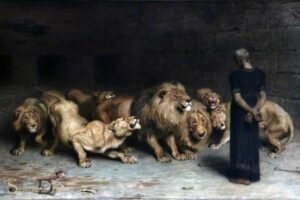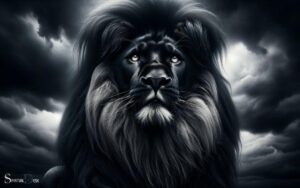The Lion the Witch And the Wardrobe Spiritual Meaning
The Lion, The Witch, and The Wardrobe have a rich spiritual meaning. It is a powerful allegory for Christian faith and values, as the four children in the story serve as a spiritual representation of Jesus and his disciples.
The lion, Aslan, serves as a representation of Jesus, being loving, powerful, and sacrificial. The White Witch serves as an allegory for Satan, tempting the children and trying to manipulate them in order to achieve her own ends.
“The Lion, The Witch, and The Wardrobe” is more than a children’s fantasy novel. The author, C.S. Lewis, was a well-known Christian apologist, and he incorporated significant Christian themes and allegories into the story.
Aslan’s sacrificial death and resurrection are parallel to the crucifixion and resurrection of Jesus. Similarly, the character of Edmund embodies the human susceptibility to temptation and the possibility of redemption.
The Lion, The Witch, and The Wardrobe is a timeless classic that speaks to the sense of truth and wonders that is accessible to all.
8 Aspects: Spiritual Meaning of The Lion, the Witch, and the Wardrobe
| Aspect | Spiritual Meaning |
|---|---|
| The Lion | Aslan, the lion, represents Jesus Christ, embodying sacrifice, power, and redemption. |
| The Witch | The White Witch symbolizes evil, temptation, and the devil. |
| The Wardrobe | The wardrobe serves as a portal to another world, representing spiritual awakening and transformation. |
| Edmund’s betrayal | Edmund’s betrayal of his siblings for Turkish delight represents human sin and weakness. |
| Aslan’s sacrifice | Aslan’s sacrifice for Edmund mirrors Jesus’ sacrifice for humanity’s sins. |
| Resurrection | Aslan’s resurrection signifies the victory of good over evil and the promise of eternal life. |
| Battle | The battle between Aslan’s forces and the White Witch’s army symbolizes the ongoing struggle between good and evil in the spiritual realm. |
| The Four Thrones | The four thrones at Cair Paravel represent the spiritual authority and responsibility bestowed upon the Pevensie children. |
Key Takeaway

Five Spiritual Meanings and Symbols in “The Lion, the Witch, and the Wardrobe”
The Symbolism Of The Lion
The chronicles of narnia: the lion, the witch, and the wardrobe by c. s. Lewis is a fantastical tale that captivates readers with its rich symbolism.
One of the key symbols in the book is the character of aslan, the majestic lion who represents christ.
In this section, we will delve into the spiritual meaning behind aslan and the symbolism of the lion in various religious and spiritual traditions.
We will also explore how aslan�s sacrificial act mirrors christ�s crucifixion, highlighting the profound connection between the two figures.
Discuss The Character Of Aslan As A Representation Of Christ
- Aslan is depicted as a powerful, compassionate, and wise figure, mirroring key attributes of christ.
- Like christ, aslan possesses a divine nature and is described as the creator and guardian of narnia.
- Aslan�s selfless nature is evident throughout the story, as he goes to great lengths to rescue and protect the children.
- The character of aslan also showcases christ-like forgiveness and mercy, offering redemption to edmund despite his betrayal.
- Aslan�s resurrection from death further emphasizes his connection to christ and his triumph over evil.
Explore The Symbolism Of The Lion In Various Religious And Spiritual Traditions
- In christianity, the lion is often associated with strength and courage, symbolizing the power and majesty of god.
- In ancient egyptian mythology, the lion-headed goddess sekhmet represented both destruction and healing.
- In hinduism, the lion is a symbol of royalty and power, often associated with the goddess durga.
- Native american cultures often view the lion as a symbol of protection, courage, and wisdom.
- In african folklore, the lion is seen as the king of the jungle, embodying leadership and authority.
Highlight How Aslan�S Sacrificial Act Mirrors Christ�S Crucifixion
- Just as christ willingly sacrificed himself on the cross for the sins of humanity, aslan offers himself as a substitute for edmund�s life.
- Aslan�s death and subsequent resurrection mirror christ�s crucifixion and resurrection, depicting the ultimate victory over evil.
- Through aslan�s sacrifice, the deeper spiritual message of redemption, forgiveness, and atonement is conveyed, echoing the christian belief in christ�s crucifixion as a means of salvation.
- The act of sacrifice also portrays love in its purest form, highlighting the sacrificial love that christ demonstrated on the cross.
The lion symbolizes various aspects of spirituality and holds profound significance in religious traditions across the globe.
Within the context of the lion, the witch, and the wardrobe, the character of aslan represents christ, embodying divine attributes, selflessness, and redemption.
Aslan�s sacrificial act mirrors christ�s crucifixion, serving as a powerful reminder of the transformative power of love and sacrifice.
The Witch�S Temptation And Sin
The white witch in �the lion, the witch, and the wardrobe� plays a crucial role in tempting the children and leading them towards sin.
Her character is deeply rooted in evil and represents the ultimate temptation for the protagonists.
Examine The Character Of The White Witch And Her Role In Tempting The Children:
- The white witch, also known as the queen of narnia, is a powerful and malevolent being who holds the land of narnia in the grip of eternal winter.
- She capitalizes on edmund�s weaknesses and lures him into her grasp by exploiting his desire for power, tempting him with promises of becoming a prince and ruling alongside her.
- With her seductive and persuasive manner, she offers edmund enchanted turkish delight, tapping into his greed and vanity to manipulate him further.
- Throughout the story, the white witch uses her charm and cunning to entice the children, attempting to turn them against aslan and his rightful rule over narnia.
Discuss The Concept Of Sin And Its Consequences Within The Story:
- Sin, in this context, refers to actions that go against moral or divine law, resulting in negative consequences.
- Edmund�s sin of betraying his siblings by aligning himself with the white witch leads to dire consequences not only for himself but also for narnia as a whole.
- The white witch�s manipulation and temptation of edmund highlight the harmful consequences of giving in to sin and the destructive impact it can have on oneself and those around them.
- As the story unfolds, the consequences of edmund�s sin become evident, causing suffering, loss, and endangerment for the innocent creatures of narnia.
Analyze How The Children�S Actions Parallel Biblical Teachings On Temptation And Sin:
- The children�s journey through the wardrobe into the magical world of narnia mirrors the biblical narrative of the garden of eden, where adam and eve faced temptation.
- Like eve, edmund is enticed by the white witch and succumbs to temptation, while his siblings strive to resist her influence.
- The consequences of edmund�s actions parallel the biblical concept of original sin, where the disobedience of one person can bring about suffering and consequences for many.
- Aslan�s sacrifice to save edmund draws parallels to the redemption and forgiveness offered through jesus christ, reinforcing the biblical message that repentance and redemption are possible even after succumbing to temptation.
In �the lion, the witch, and the wardrobe,� the white witch�s temptation and sin play a significant role in shaping the story and teaching valuable spiritual lessons.
The story serves as a powerful reminder of the consequences of giving in to temptation, the importance of resisting sin, and the possibility of redemption through sacrifice and forgiveness.
The Wardrobe As A Portal
Have you ever wondered what lies behind the doors of an old wardrobe? In the enchanting tale of �the lion, the witch, and the wardrobe,� the wardrobe serves as a mysterious portal to the magical world of narnia.
Intriguingly, this concept of a wardrobe as a gateway to another realm is not unique to c.
s. Lewis� story. Portals have long been recognized in spiritual and mythological traditions as gateways to other dimensions or realms.
Explain The Significance Of The Wardrobe As A Portal To The Magical World Of Narnia
- The wardrobe in �the lion, the witch, and the wardrobe� acts as a mystical gateway to the hidden world of narnia, a place where magical creatures and enchanting adventures await.
- The wardrobe�s portrayal as an ordinary piece of furniture concealing the extraordinary not only captivates the characters in the story but also captures the imaginations of readers who are drawn into this captivating world.
- The physical act of entering the wardrobe and stepping into narnia represents a literal and metaphorical journey from the ordinary to the extraordinary.
Explore The Concept Of Portals In Spiritual And Mythological Traditions
- Portals have been recognized in numerous spiritual and mythological traditions as gateways to other dimensions, realms, or states of consciousness.
- Ancient cultures often depicted portals in their mythology and folklore, representing the thresholds between the mortal and divine realms.
- Spiritual practices such as meditation, prayer, and ritual have been likened to the act of entering a portal, transporting individuals to a deeper state of awareness and connection with the spiritual realm.
Discuss The Metaphorical Meaning Of The Wardrobe As A Gateway To Spiritual Awakening
- The wardrobe serves as a powerful metaphor for the search for spiritual awakening and self-discovery.
- Just as the characters in the story stumble upon the hidden world of narnia through the wardrobe, individuals on a spiritual journey may stumble upon moments of profound insight or awakening.
- The act of stepping through the wardrobe can symbolize a willingness to venture beyond the familiar and explore the depths of one�s own spirituality.
- The wardrobe reminds us that spiritual awakening often requires a leap of faith, a willingness to embrace the unknown and venture into uncharted territory.
The wardrobe as a portal not only transports characters to a magical world but also invites readers to reflect on their own journeys of self-discovery and spiritual awakening.
Just as lucy, peter, susan, and edmund experienced transformation through their encounters in narnia, we too can find inspiration and meaning in the metaphorical depths of the wardrobe.
Redemption And Resurrection
The lion, the witch, and the wardrobe is much more than just a children�s fantasy novel. It is a tale that delves into deep spiritual themes, including redemption and resurrection.
Explore The Themes Of Redemption And Resurrection Within The Narrative
- The character of aslan, the majestic lion, represents christ and his sacrifice for humanity.
- Aslan�s sacrificial death and subsequent resurrection mirror the biblical story of jesus� crucifixion and resurrection.
- The deep magic, which requires a life to be sacrificed as payment for treachery, symbolizes the divine justice and the necessity of atonement.
- Edmund�s redemption journey exemplifies the power of forgiveness and the opportunity for personal transformation.
Analyze The Characters� Transformation And Growth Throughout The Story
- Edmund starts as a selfish and deceitful character but undergoes a profound change, redeemed by aslan�s sacrifice and the forgiveness extended to him.
- Peter evolves from a hesitant and unsure young boy into a confident and responsible leader.
- Susan becomes more compassionate and nurturing, embracing her role as the group�s caregiver.
- Lucy�s unwavering faith and innocence allow her to experience a deep connection with aslan and grow in courage and conviction.
Discuss How These Themes Align With Various Religious And Spiritual Beliefs
- The themes of redemption and resurrection resonate with christianity, as they parallel the story of jesus� sacrifice for the salvation of humanity.
- Other religious and spiritual belief systems also have similar concepts of redemption and rebirth, emphasizing the possibility of personal transformation and growth.
- These universal themes can inspire individuals of different faiths or no religious affiliation, as they reflect the inherent human desire for redemption and second chances.
The lion, the witch, and the wardrobe not only captivate readers with its enchanting story but also explores profound spiritual themes.
Through the themes of redemption and resurrection, the narrative offers insights into forgiveness, personal transformation, and the power of faith.
Whether one approaches the story from a religious or spiritual perspective, these themes can resonate deeply and provide valuable lessons and inspiration for all.
FAQ About The Lion The Witch And The Wardrobe Spiritual Meaning
Conclusion
�the lion, the witch, and the wardrobe� holds significant spiritual meaning for readers of all ages. Through the story of four children stepping into a magical world, author c. s. Lewis beautifully conveys powerful themes of sacrifice, redemption, and the ultimate triumph of good over evil.
Aslan, the lion who sacrifices himself for the sake of others, represents jesus christ and his sacrifice for humanity. The white witch symbolizes the temptations and evil that exist in the world, while the pevensie children�s journey parallels the journey of self-discovery and faith.
This beloved fantasy novel encourages readers to reflect on the importance of trust, forgiveness, and loyalty, reminding us that there is always hope and light even in the darkest of times.
Imbued with profound spiritual lessons, �The lion, the witch, and the wardrobe� serves as a timeless reminder of the enduring power of love and faith in our lives.
Bonus: The Lion the Witch And the Wardrobe Spiritual Meaning
What is the Spiritual Meaning of Narnia?
Narnia is a place of mystical wonder and great spiritual meaning. It is said to be the doorway to another world, a place where one can find their true self.
Narnia is also said to be a place of healing and transformation, a place where one can let go of their past and start anew. There are many stories and legends surrounding Narnia, all of which add to its mystique and spiritual power.
Some say that Narnia is actually an alternate universe, a parallel world that exists alongside our own. Others believe that Narnia is a representation of Heaven or the afterlife, a place where we go when we die.
How is the Lion the Witch And the Wardrobe Similar to the Bible?
The Chronicles of Narnia: The Lion, the Witch, and the Wardrobe is a fantasy novel for children written by C. S. Lewis and published in 1950.
It tells the story of four siblings�Peter, Susan, Edmund, and Lucy Pevensie�who are sent to live with an old professor during World War II while their mother is away on business.
The children discover a wardrobe in the professor’s house that leads to the magical world of Narnia.
There they meet Aslan, a lion who is the rightful king of Narnia but has been overthrown by the evil White Witch. The siblings help Aslan overthrow the witch and restore peace to Narnia.
While The Lion, the Witch, and the Wardrobe is a work of fiction, it contains many elements that are similar to stories found in the Bible.
For example, Aslan represents Jesus Christ while the White Witch represents Satan. Both figures sacrifice themselves for others (Aslan for Edmund and Jesus for humanity) and both are resurrected afterward (Aslan by Father Christmas and Jesus by God).
In addition, both stories feature talking animals, magical creatures, and battles between good and evil. While there are many similarities between The Lion, the Witch, and the Wardrobe and stories from the Bible, there are also some important differences.
One key difference is that Aslan is not Almighty God; he is merely a creature who serves as a symbol for Jesus Christ.
In addition, whereas Christianity teaches that everyone has sinned and needs salvation through faith in Jesus Christ alone, C.S Lewis’ story suggests that one can earn redemption through acts of bravery or self-sacrifice.
Finally, whereas Christianity teaches that there will be a final battle between good and evil at the end of time (Armageddon), The Lion, the Witch, and the Wardrobe does not make any mention of this event taking place within its fictional world of Narnia.
Christian Symbolism in the Lion, the Witch, And the Wardrobe
When reading The Lion, the Witch, and the Wardrobe, it is impossible to miss the Christian symbolism present throughout the story.
From Aslan�s self-sacrifice to Lucy�s role as a Christ figure, Christianity is woven into the very fabric of this classic children�s tale.
Aslan, the great lion, and ruler of Narnia is clearly meant to represent Jesus Christ. He is all-powerful yet gentle, loving, and wise. When Edmund betrays his siblings and Aslan by aligning himself with the White Witch, he knows he must face punishment.
However, Aslan sacrificially takes Edmund�s place even though he has done nothing wrong. This correlates directly with Christ�s sacrifice on the cross for our sins.
In addition to Aslan, Lucy also serves as a Christ figure in The Lion, the Witch, and the Wardrobe.
Like Jesus, she spreads light and love wherever she goes. She also brings hope to those who are lost or hurting � like when she helps Mr. Tumnus after he has been turned into stone by the White Witch.
In many ways, Lucy embodies what it means to be a follower of Christ. The Christian themes present in The Lion, the Witch, and the Wardrobe provide an excellent opportunity for discussion with kids (or anyone!) about what it means to follow Jesus.
The Lion, the Witch, And the Wardrobe Themes
If you’re a fan of The Chronicles of Narnia, then you know that The Lion, the Witch, and the Wardrobe is one of the most popular books in the series. And with good reason – it’s a classic story that’s full of excitement and adventure.
But beyond that, there are also some important themes at play in the book. Here are just a few of them:
But it’s also an important theme because it teaches children (and adults!) that even when things seem hopeless, goodness will always triumph in the end.
These relationships are tested time and again throughout the course of the story but they ultimately remain strong – which goes to show that true friendships can weather any storm.
Who Do the Characters in the Lion, the Witch, And the Wardrobe Represent?
The Lion, the Witch, and the Wardrobe is a beloved classic children’s book, written by C.S. Lewis and published in 1950.
The story tells of four siblings – Peter, Susan, Edmund, and Lucy – who are sent to live in the country during World War II, where they discover a wardrobe that leads to the magical land of Narnia.
In Narnia, they meet many strange creatures, including the wise and noble lion Aslan, who represents Christ. The evil White Witch is a symbol of Satan, while her henchman Maugrim stands for sinfulness and death.
Edmund’s betrayal of his siblings by the Witch is representative of Judas’ betrayal of Jesus. Ultimately, good triumphs over evil as Aslan sacrifices himself to save Edmund from execution, thereby defeating the Witch’s power.
The story has been adapted numerous times for stage and screen, most recently in 2005 with a film version starring Tilda Swinton as the White Witch.
The Lion, The Witch, And The Wardrobe are one of those stories that have stood the test of time due in large part to its complex and deeply layered allegory.
At its core, the story is about Christianity � more specifically about sacrifice, atonement, and redemption � but it also contains elements of Greek mythology (Aslan) and British history (the Battle between good King Arthur & bad King Mordred).
All of these different elements come together to create a timeless tale that has resonated with readers for generations.





